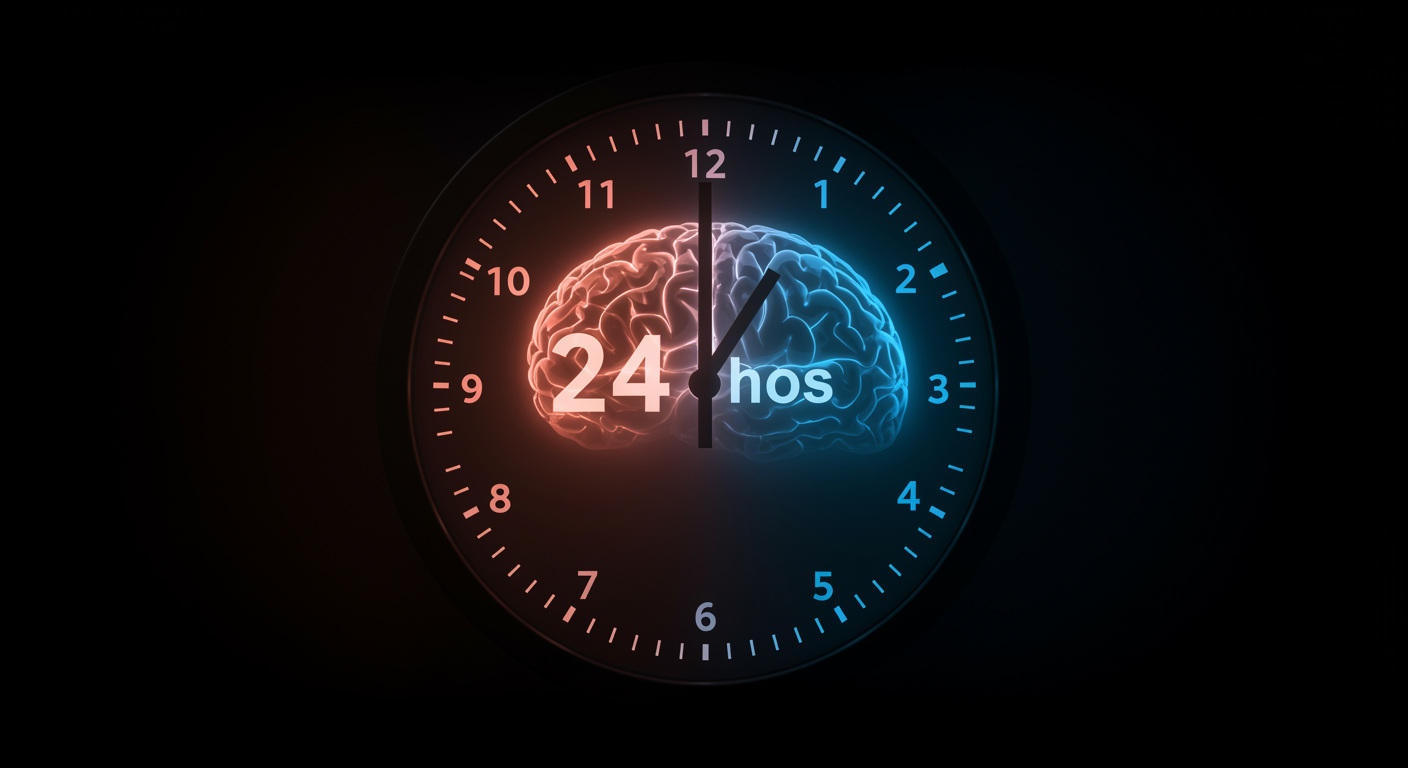How Long Is the Human Internal Clock, and Why Does It Matter?
The human circadian pacemaker runs approximately 24.2 hours when isolated from external time cues, slightly longer than Earth’s 24-hour day. This precision research, conducted in controlled laboratory environments free from light and time cues, reveals why humans need daily light exposure to stay synchronized with the external world. Without this daily “reset” from bright light, our internal clocks would gradually drift later each day, explaining why maintaining proper light exposure is crucial for healthy sleep-wake cycles.
Dr. Kumar’s Take
This research explains so much about human sleep behavior and why we struggle with certain circadian challenges. The fact that our internal clock runs 24.2 hours means we have a natural tendency to drift toward later bedtimes and wake times—which explains why it’s easier to stay up late than to wake up early, and why teenagers naturally shift toward later sleep schedules. We literally need bright light every day to pull our clocks back into alignment with the 24-hour world. This is why people who don’t get adequate light exposure, especially morning light, often experience delayed sleep phase and have trouble maintaining normal sleep schedules. Understanding this 0.2-hour daily drift helps explain why light therapy is so effective for circadian disorders and why consistent light exposure is fundamental to good sleep hygiene.
Key Findings
Studies conducted in temporal isolation facilities—environments completely free from time cues including light, clocks, and social schedules—revealed that the human circadian period averages 24.18 hours, with individual variation ranging from about 23.9 to 24.6 hours. This intrinsic period, called tau, represents the natural rhythm of the human biological clock when running freely without external synchronization.
The research showed remarkable precision and stability in individual circadian periods, with each person maintaining a consistent internal rhythm that varies by only minutes from day to day. However, the slight difference between the internal clock (24.2 hours) and the external day (24.0 hours) means that without daily light exposure, humans would gradually shift to later and later sleep times.
Studies also revealed that the circadian system shows strong individual differences, with some people having naturally shorter periods (closer to 24 hours) and others having longer periods (up to 24.6 hours), which may contribute to natural morning lark versus night owl tendencies.
Brief Summary
This research was conducted in specialized temporal isolation facilities where participants lived for weeks without any time cues, including natural light, clocks, schedules, or social contacts. Researchers monitored sleep-wake cycles, body temperature rhythms, and hormone patterns to determine the intrinsic period of the human circadian pacemaker. The studies involved healthy adults of various ages and used continuous monitoring to track how biological rhythms behaved when free-running without external synchronization. The research provided precise measurements of human circadian period length and its individual variation.
Study Design
These landmark studies used controlled temporal isolation protocols in specially designed laboratory facilities. Participants lived in windowless environments with constant dim light or self-selected light-dark cycles while researchers monitored multiple circadian markers including sleep-wake patterns, core body temperature, and melatonin rhythms. The isolation periods lasted 2-4 weeks to allow accurate measurement of free-running circadian periods. Sophisticated data analysis techniques determined individual circadian period lengths and assessed the stability and precision of human biological clocks across different conditions.
Results You Can Use
The human circadian pacemaker has an intrinsic period of approximately 24.18 hours (24 hours and 11 minutes), with individual variation typically ranging from 23.9 to 24.6 hours. This means that without daily light synchronization, most people would naturally drift toward later sleep and wake times by about 11 minutes each day. Over a week, this would result in sleeping nearly 1.5 hours later than the previous week.
The research revealed that individual circadian periods are remarkably stable and consistent, representing a fundamental biological characteristic of each person. People with shorter intrinsic periods (closer to 24 hours) may naturally be morning types, while those with longer periods may be evening types.
The findings explain why daily light exposure, particularly bright morning light, is essential for maintaining synchronization with the 24-hour world and why people who lack adequate light exposure often experience delayed sleep phase syndrome.
Why This Matters For Health And Performance
Understanding the human circadian period explains many aspects of sleep disorders and circadian rhythm problems. The natural tendency to drift later explains why delayed sleep phase syndrome is common, especially in teenagers and young adults whose circadian periods may be even longer. It also explains why shift workers and people with irregular schedules struggle to maintain stable sleep patterns—they’re fighting against their natural biological tendency to drift.
The research provides the scientific foundation for light therapy and explains why timing of light exposure is crucial for maintaining healthy circadian rhythms. It also helps explain individual differences in chronotype (morning lark vs. night owl tendencies) and why some people adapt better to certain schedules than others.
How to Apply These Findings in Daily Life
- Get bright morning light daily: This is essential for pulling your 24.2-hour clock back into sync with the 24-hour day
- Maintain consistent light exposure: Regular light patterns help stabilize your circadian rhythm and prevent drift
- Understand your natural tendency: Recognize that without light cues, you’ll naturally drift toward later sleep times
- Use light therapy strategically: Bright light in the morning advances your clock, while evening light delays it
- Be patient with schedule changes: Your internal clock needs time to adjust to new schedules due to its intrinsic period
- Consider individual differences: Some people may need more or different light exposure based on their natural circadian period
Limitations To Keep In Mind
This research was conducted in highly controlled laboratory environments that don’t reflect normal living conditions. The studies involved relatively small numbers of participants and may not represent all populations or age groups. Individual differences in circadian period and light sensitivity are significant, and optimal light exposure strategies may vary between people. Additionally, factors like age, genetics, and health conditions can influence circadian period and synchronization requirements.
Related Studies And Internal Links
- Your Brain’s Master Clock: Suprachiasmatic Nucleus Controls Circadian Rhythms
- Sleep Stages Explained: Your Nightly Journey Through REM and NREM Sleep
- Sleep’s Role in Emotional Brain Function: Mood Stability
- Sleep: The Price of Plasticity - Brain Restoration
- How to Sleep Better: Science Daily Playbook
FAQs
Why is the human circadian clock longer than 24 hours if we evolved on a 24-hour planet?
This remains an active area of research, but the slightly longer period may provide flexibility for adapting to seasonal changes in daylight or may be a byproduct of other evolutionary pressures. The key is that light exposure can easily synchronize the clock to 24 hours.
Do all humans have the same circadian period length?
No, there’s significant individual variation, typically ranging from 23.9 to 24.6 hours. This natural variation contributes to differences in chronotype and may explain why some people are naturally morning larks or night owls.
Can you change your natural circadian period?
While your intrinsic period is relatively fixed, you can use light exposure and other strategies to synchronize your clock to different schedules. However, working against your natural period (like extreme early rising for a natural night owl) may always require ongoing effort.
Conclusion
The human circadian pacemaker runs approximately 24.2 hours, slightly longer than Earth’s 24-hour day, requiring daily light exposure to maintain synchronization. This intrinsic period explains our natural tendency to drift toward later sleep times and why consistent bright light exposure, especially in the morning, is essential for healthy circadian rhythms.


